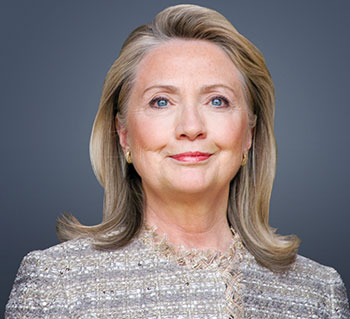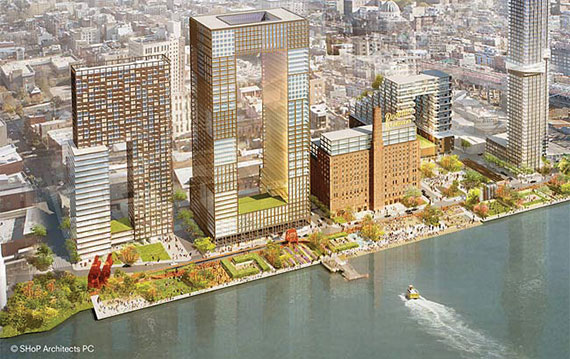If there were any outstanding questions about Brooklyn’s viability as an office market, they were put to rest last month, when Hillary Clinton signed on for a large block of space in Brooklyn Heights.
Clinton’s decision to take nearly 78,000 square feet of space for her 2016 presidential campaign headquarters at 1 Pierrepont Plaza is only expected to add momentum to the Brooklyn office market.
While it is often overshadowed by the borough’s booming residential market, commercial brokers say there has never been more demand for office space in Brooklyn.
“There’s a tsunami of people hoping to take advantage of the Brooklyn office market,” said Timothy King, managing partner at Brooklyn-based CPEX Real Estate Services. “It used to be a back-office bastion, and today it’s flourishing as one of the most desirable places to be in the city.”
However, with residential development more lucrative than ever in the borough, the incentive for investors to build commercial development is still limited.
“It is a very tight office market … the numbers are far better to go residential,” said Joe Cirone, senior director of brokerage at the commercial firm Cushman & Wakefield.

Hillary Clinton signed on for office space in the borough.
Nonetheless, at least 2.5 million square feet of office space is coming to the Brooklyn market in the next few years, according to Cushman & Wakefield research. The vast majority of that space is not brand-new Class A buildings going up in Downtown Brooklyn; it’s redeveloped industrial space, or other existing buildings originally designed for none-office use, now geared mainly toward creative-type tenants. The pipeline, brokers say, is full of units for those perhaps dreaming of becoming the next company to be bought by Google or Facebook.
The most high-profile Brooklyn office project, of course, is courtesy of Kushner Companies and RFR Realty, who teamed up in 2013 to buy the Jehovah’s Witness Watchtower complex in Dumbo for $375 million. The complex, which is being redubbed “Dumbo Heights,” will contain 963,000 square feet of office space and is slated for completion this year. Asking rents there are up to $60 per square foot, sources said.
Meanwhile, Midtown Equities’ Empire Stores development in Dumbo is expected to open this fall and bring roughly 385,000 square feet of office space to the market. It has made waves, with record-breaking asking rents climbing as high as $85 per square foot.
In addition, the Brooklyn Navy Yard, which already has 4 million square feet of space in use, is adding another 2 million square feet of office space by 2017. And further down the line, Jamestown is in the midst of converting its massive Industry City project in Sunset Park, reviving 6.5 million square feet of dilapidated manufacturing space by 2027. Both of these developments also contain light manufacturing components.
Richard Warshauer, senior managing director at Colliers International, said new construction is traditionally “the bellwether of the viability of any real estate market.”
“The extent to which one sees new construction is a leading indicator of how that market’s doing,” he said. “But in Brooklyn, there’s a different dynamic: More space is being converted into offices than is being built ground up.”
A variety of factors are driving the market for office conversions in the borough, including limited space, the lack of impetus for new commercial developments compared to residential ones and the class of tenants seeking to make a home in Brooklyn.
Creative tenants, not surprisingly, are behind much of the demand for Brooklyn office space.
“It’s a market that didn’t exist before,” Ofer Cohen, founder and president of Brooklyn commercial brokerage TerraCRG, told The Real Deal. “These are start-up companies being founded by an entrepreneur who lives, loves Brooklyn and thinks, ‘Why do I have to go to Chelsea?’ ”
E-commerce website Etsy, which was founded in the borough, is a prime example, said Tucker Reed, president of the Downtown Brooklyn Partnership, the business improvement district that lobbies on behalf of the area. Last year, the company signed a lease for nearly 169,000 square feet at the Dumbo Heights project.
“There’s plenty of evidence that creative class companies, in particular, are eager to invest in this area,” agreed David Lombino, director of special projects for Two Trees Management.
Lombino cited Kickstarter’s 2012 purchase of its 29,000-square-foot headquarters in Greenpoint, and Vice Media’s 70,000-square-foot lease in Williamsburg, signed last year. Shared space providers are also moving into the market, with WeWork committing to more than 160,000 square feet at Dumbo Heights and Cowork|rs signing on to 42,000 square feet at a rehabilitated Gowanus industrial building.

Two Trees’ Domino Sugar Factory redevelopment will include 500,000 square feet of office space.
That eagerness from technology, advertising, media and information technology tenants — the so-called TAMI sector — is driving Two Trees’ hopes for its redevelopment of the former Domino Sugar refinery in Williamsburg, a mixed-use plan that will include 500,000 square feet of commercial office space.
Two Trees “actually reduced the amount of residential space and increased the amount of commercial space, as was allowed,” Lombino said.
Cohen speculated that there is roughly 20 million square feet of space in the borough that could potentially be redeveloped for commercial use in the coming decades through “flexible zoning.”
While such widespread redevelopment would take years, if not decades, to come to fruition, Cohen said the Brooklyn market is “hungry for a creative, cool office experience.”
“It’s not a commodity space,” he said. “People want a specific kind of space, and that’s the space developers are trying to cater to.”
Of course, such space can’t simply crop up alone; there are logistical considerations that must be taken into account. Cohen mentioned the importance of amenities, like nearby dining options, to an office development’s desirability, while also noting that unreliable high-speed Internet connections are a reality at some converted properties.
But the demand is there, and commercial brokers and developers alike recognize the importance of meeting it.
“People come to Brooklyn from Manhattan, and they have certain expectations; they expect the gritty office space with great light and great views,” Cirone noted. “While it certainly does exist, it’s in short supply because it got swallowed up by predominantly growing Brooklyn companies.”
“But I think you’re gonna see more of it come online in the next 18 months,” he added.
Low vacancies
Still, the office space coming down the pike for creative-type tenants is several years out, and current demand is putting pressure on Brooklyn’s existing office supply, particularly Class A space.
The strain on inventory is perhaps no more obvious than in Downtown Brooklyn, the traditional epicenter of the borough’s office market.
The neighborhood is experiencing “historic lows” in vacancy rates, according to Reed.

TerraCRG’s Ofer Cohen
The availability rate in Downtown Brooklyn stood at 7.4 percent in 2015’s first quarter, below the 10-year average of 7.9 percent, according to Newmark Grubb Knight Frank.
The level of difficulty in finding office space in the Brooklyn market “depends on what one’s looking for,” Warshauer said, with tenants in search of larger spaces around or in excess of 50,000 square feet finding it “very difficult.”
“It also has to do with the consumer’s level of expectation,” he added. “If the consumer’s looking for Class A buildings, it’s starved. And that’s because nobody built any Class A buildings of any size [in Brooklyn] from the Great Depression to MetroTech,” in 1990.
The MetroTech Center itself, long the standard for Class A office space in the borough, is virtually leased out. “There’s no space in MetroTech,” said Warshauer, a former Forest City Ratner vice president who oversaw commercial leasing at the complex. “The only space they have is two relatively small subleases.”
The complex has drawn younger companies in recent times, diversifying its traditional base of financial and government tenants. The Tough Mudder event series relocated to MetroTech from Dumbo in 2013, while 3D printer manufacturer MakerBot signed on in 2012.
But space constraints, at MetroTech and other office properties, affected leasing activity in the Downtown/Dumbo area through the first three months of 2015. The availability of large blocks was “particularly limited,” Newmark Grubb noted, with just 10 blocks of space above 20,000 square feet available.
Those conditions have resulted in price increases, with average asking rents in the Downtown area of just over $39 per square foot in the first quarter, up from about $29 for the 10-year average, according to Newmark Grubb.
“The market’s changed. There’s more demand and less space every day,” said commercial broker Christopher Havens of Aptsandlofts.com. “There’s just more tenants than space.”
noted. “While it certainly does exist, it’s in short supply because it got swallowed up by predominantly growing Brooklyn companies.”
“But I think you’re gonna see more of it come online in the next 18 months,” he added.
